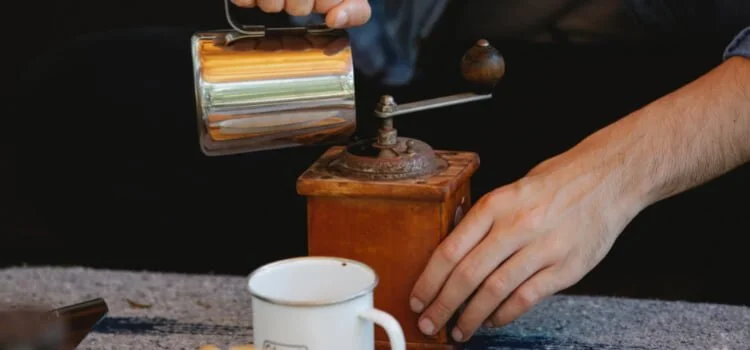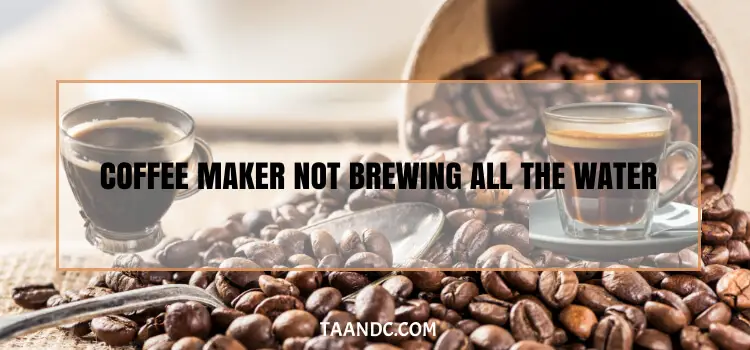Can you brew coffee beans without grinding? Certainly! Drawing from my experience, I’ve found that while grinding enhances flavor, it’s possible to brew with whole beans. Opt for a longer steeping time to extract flavors. Experiment with methods like cold brew or French press, adjusting the steeping duration to your taste. Remember, patience is key – let those beans steep to perfection. While grinding offers an edge, brewing without it is a delightful venture, unfolding layers of taste in every sip.

What is Coffee Brewing?
Coffee brewing is preparing coffee using hot water and coffee grounds. There are several methods of brewing coffee, each resulting in a unique flavor profile. Some standard techniques include drip coffee makers, French presses, and manual grinders. One of the critical factors in producing a flavorful cup of coffee is using freshly roasted coffee beans. These beans contain flavor compounds that begin to degrade over time. Grinding the beans to the correct texture is also essential for optimal flavor. A finer grind is typically used for drip coffee makers, while a coarser grind is preferred for a French press. Manual grinders allow for more control over the grind size, ensuring consistency.
Hot water is poured over the coffee grounds to brew coffee. After a few minutes, the resulting liquid is filtered to remove the grounds. Although the ratio of coffee to water can differ, a commonly accepted guideline is to utilize 1-2 tablespoons of coffee for every 6 ounces. Coffee brewing is a simple yet essential process for any coffee drinker. By grinding freshly roasted beans properly, you can create a fresh cup of coffee with optimal flavor.
Understanding the Role of Grinding in Coffee Brewing
Grinding is essential in the coffee brewing process as it directly affects your cup of coffee’s flavor, aroma, and caffeine content. Grinding coffee beans releases flavor and aroma compounds that mix with the water during brewing. Thus, the quality of the grind can make or break the flavor of your cup of coffee.
Ground coffee has a more significant surface area than whole-bean coffee, leading to a quicker and more robust extraction of flavor compounds during brewing. Additionally, finer grinds extract more caffeine than coarser ones, leading to a more bitter taste.
You can use various grinders to grind coffee beans, including blade grinders, manual grinders, food processors, and burr grinders. The recommended grind sizes vary depending on the brewing method. For instance, drip coffee makers require a medium grind, while French presses require a coarser grind. Cold brew coffee, on the other hand, requires a very coarse grind.
Understanding the role of grinding in coffee brewing is crucial to achieving a fresh and flavorful cup of coffee. To achieve the best results, use fresh whole-bean coffee, grind your beans appropriately for your brewing method, and be mindful of the grinding process’s consistency.
Can you brew coffee beans without grinding them?
Yes, you can brew coffee beans without grinding them; however, the flavor may be better than that of pre-ground coffee. Various methods for brewing unground coffee beans include a drip coffee maker, a French press, manual grinders, a food processor, and a mason jar.
A traditional drip coffee maker is the easiest way to brew coffee without grinding the beans. Still, it may not result in the best flavor. French press is another option that can produce a more robust and more prosperous cup of coffee. However, it requires a coarser grind and more elbow grease. Manual grinders can also be used but may not produce a consistent grind.
Another way to grind coffee beans is by using a food processor. Still, it may produce a grind of a different quality than that of a coffee grinder. Lastly, for cold brew coffee, an option is the mason jar method, where coffee beans are steeped in hot water for an extended period and then filtered.
Overall, suppose you’re going to brew coffee from unground coffee beans. In that case, it’s essential to experiment with different methods and find the one that best suits your taste. Additionally, use fresh water and allow the coffee to brew appropriately for the best flavor experience.
Types of Coffee Brewers
Coffee is one of the most consumed beverages worldwide. Whether it’s a morning pick-me-up or a midday energy boost, a cup of coffee can be the perfect solution. But did you know that there are different ways to brew coffee? Each method has its characteristic flavor, texture, and aroma. Below, we’ll take a closer look at some of the most popular types of coffee brewers that can help you achieve your desired taste. So, please put on your barista apron, and let’s dive in!
Drip Coffee Maker
A drip coffee maker is a popular appliance for coffee drinkers. The drip coffee maker works at its core by heating water and pouring it over pre-ground coffee beans. To produce a fresh cup of coffee, the ground beans are placed in a coffee filter, and hot water slowly drips through the filter into an insulated container.
One of the main benefits of a drip coffee maker is a consistent grind. Unlike manually grinding unground coffee beans with different grind sizes, a drip coffee maker can produce a uniform grind to improve coffee’s flavor. However, the drip coffee maker can also lead to oxidation since the grounds are exposed to air and oxygen during brewing. This can affect the flavor compounds and aroma of the coffee.
Some drip coffee makers include manual pour-over, automatic, and single-serve machines. Manual pour-over coffee makers give the user more control over the brewing process, creating a customized cup of coffee. Automatic coffee makers simplify brewing by automatically heating water and dispensing it over the coffee grounds. Single-serve machines are ideal for only one fresh cup of coffee.
Lastly, drip coffee makers offer convenience and consistency in brewing but also have potential drawbacks. Choosing the correct type of machine depends on personal preferences and brewing needs.
French Press
The French Press, a press pot, coffee press, or plunger pot, is a classic brewer that has been popular for decades. Its simple design allows you to brew a rich, robust cup of coffee with minimal effort. You will require coarsely ground coffee beans and hot water to utilize a French Press. Add the coffee grounds to the press pot and pour in the hot water. Allow the coffee to steep for a few minutes before gradually pressing down on the plunger to remove the ground. The result is a bold, full-bodied cup of coffee that retains all its natural oils and flavors.
Using a French Press provides the advantage of having more authority in the brewing procedure. You can customize your coffee’s strength by adjusting the coffee’s ratio to water and the steeping time. Additionally, the mesh filter of a French Press captures all the delicious flavor compounds and oils from the coffee, giving you a fuller and richer taste. Lastly, the French Press is an excellent option if you are looking for a no-fuss method to enjoy a flavorful cup of coffee. It’s simple, easy to use, and produces a delicious brew.
Manual Grinders
Grinding coffee beans cannot be overstated in coffee brewing. While electric grinders are the most common choice for many coffee drinkers, manual grinders are gaining popularity. These grinders require a bit of elbow grease, but they offer a range of benefits, including control over grind size and a more hands-on brewing process.
Manual grinders come in different types, including pestle and mortar, butcher knife, rolling pin, hammer, and hand mincer. The pestle and mortar is the most traditional method of grinding coffee beans – it involves crushing the beans with a pestle in a mortar. The butcher knife and rolling pin require more effort, and the hammer and hand mincer offer incredible speed with less effort.
According to coffee experts, manual grinders have some advantages over electric ones – they offer a consistent grind size, create less heat and friction (preventing oxidation of coffee oils), and are quieter. However, they can be time-consuming and tiring to use. On the other hand, electric grinders are fast and easy to use. Still, they can be noisy and inconsistent, depending on the grinder. The coffee drinker’s individual preferences will ultimately determine their choice.
Food Processor
A food processor can be a lifesaver when you find yourself without a coffee grinder. While a dedicated coffee grinder is the best option for a consistent grind, a food processor can work just as well in a pinch. To grind coffee beans in a food processor, first, ensure the beans are roasted and cooled to room temperature. Pour the unground beans into the processor bowl, then pulsate until you have reached the desired grind size.
It’s essential to note that using a food processor will create a coarser grind than a dedicated coffee grinder. This is because the blade of a food processor is less sharp and won’t cut through the beans as effectively as a coffee grinder. When using a food processor to grind coffee beans, tilt the machine slightly to get more beans on the bottom blade. Grind the beans in smaller batches to ensure an even grind, and don’t over-process them, as this can lead to a powdery consistency that will affect the flavor of the coffee.
Grinding coffee beans in a food processor can be effective when you need a dedicated coffee grinder. However, the resulting grind will be coarser than a coffee grinder’s. Be sure to pulse the beans for the desired consistency.
Mason Jar Method
The Mason Jar Method is a brewing technique that allows you to make coffee without a grinder. You only need a mason jar, whole coffee beans, and hot water. It’s the perfect method for those who don’t need access to a coffee grinder or prefer a coarser grind. Add the whole coffee beans to the mason jar and pour hot water to use this method. Close the lid tightly to create an airtight container and let it steep for 12-24 hours at room temperature.
Once the steeping time is completed, strain out the coffee grounds using a fine strainer or a cheesecloth, and enjoy your fresh cup of coffee. This method allows you to control the strength by adjusting the coffee-to-water ratio. The benefits of using the Mason Jar Method include a rich flavor and smooth finish. Since the coffee doesn’t go through the grinding process, the taste and aroma compounds remain intact, resulting in a fresher and tastier cup of coffee. It’s also a perfect technique for camping or travel, where a coffee grinder is yet to be available. So, give it a try, and appreciate the fantastic coffee flavors of whole beans!
Pros & Cons
Whole coffee beans are the foundation of any perfect cup of coffee. However, when it comes to making coffee, many believe that grinding the beans is essential. But believe it or not, brewing coffee without grinding the beans can be done. While it may seem strange, brewing whole coffee beans is an option for people who do not have a coffee grinder or for those who want to try something new. We will explore the pros and cons of brewing whole coffee beans to help you decide on your morning cup.
Pros of Brewing Whole Coffee Beans
Brewing your coffee using whole-bean coffee rather than pre-ground coffee beans can offer a range of benefits. Firstly, whole-bean coffee provides a fuller and richer flavor profile, unmatched by ground coffee. The volatile aroma and flavor compounds in coffee beans diminish over time when exposed to air, and this process is accelerated once the beans are ground. Therefore, if you grind your coffee beans right before you brew them, you can better preserve the aroma and flavor.
Secondly, customizing whole-bean coffee is relatively easy. With various beans available from different regions and with varying roast levels, you can mix and match different beans to create your unique coffee blend. This allows you to experiment with other flavors and aromas to suit your preferences. Finally, brewing whole coffee beans guarantees the freshest and most robust-tasting cup of coffee. So, invest in a high-quality grinder and explore the endless possibilities of creating your unique blend.
Cons of Brewing Whole Coffee Beans
While it is possible to brew whole coffee beans without grinding them, there are potential cons that can affect the taste and quality of the coffee. Brewing unground coffee beans can lead to uneven grind sizes, which can affect the extraction process and, ultimately, the flavor of the coffee. This is because the bean’s surface area is inconsistent, and the water cannot extract flavor compounds evenly. Achieving a consistent grind size requires a quality grinder to avoid this issue.
Another factor to consider when brewing whole coffee beans is the oxidation process. Exposure of coffee oils to air can lead to rancidity and negatively impact the flavor of the coffee. To prevent this, store unground coffee beans in an airtight container and minimize exposure to air.
Despite the drawbacks of brewing whole beans, methods like cold brew can offer a smoother, less acidic flavor profile. This technique uses Cold water to steep coffee grounds for a prolonged duration of 12-24 hours. Because the coffee does not experience high heat, it develops a milder flavor profile and is less susceptible to uneven grind sizes.
It is possible to brew whole coffee beans without grinding them. Uneven grind sizes and oxidation can affect coffee flavor and quality, highlighting the importance of proper grinding techniques. To achieve a fresh and flavorful cup, utilize a quality grinder or explore alternative methods like cold brew.
FAQ
Is it possible to brew coffee with whole beans?
Absolutely! While grinding enhances flavor, brewing whole beans is possible. It might require adjustments to methods and steeping times.
What methods are suitable for brewing whole coffee beans?
Methods like cold brew, French press, and immersion brewing work well. These allow extended steeping periods to extract flavors from whole beans.
Will brewing whole beans affect the coffee taste?
Brewing with whole beans might result in a slightly different flavor profile. Expect a potentially smoother and milder taste compared to freshly ground beans.
Should I adjust the brewing time when using whole beans?
Indeed, longer steeping times are often needed. This allows the water to interact more thoroughly with the beans, extracting the desired flavors.
How does brewing whole beans compare to pre-ground coffee?
Freshly grinding beans before brewing offers more intense flavors. However, brewing whole beans allows one to explore unique taste notes that might be otherwise masked by grinding.
Conclusion
Brewing whole coffee beans is possible, although grinding is generally necessary for a fresh cup of coffee. The article highlights brewing coffee without grinding beans using cold brew, French press, or soaking in hot water. There are pros and cons to brewing with whole beans versus pre-ground coffee. Whole beans preserve oils, aroma, and flavor, offering control over grind consistency and size, but require more effort and time. Pre-ground coffee, conversely, provides convenience and is often less expensive. Still, it may result in a less fresh cup of coffee with inconsistent grind sizes.



